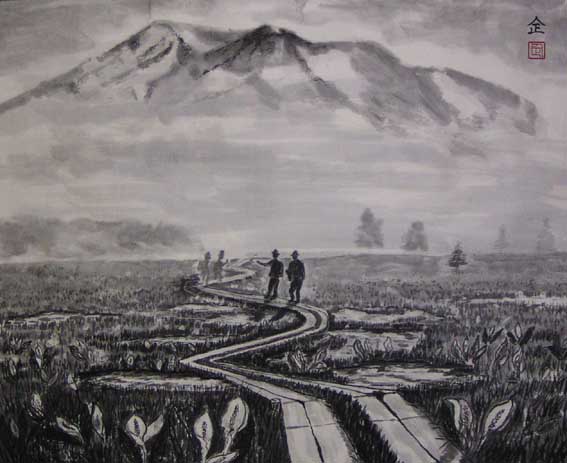| "What is "Oze" ?" |
Oze, one of the central parts of Nikko National Park,is the most scenic place all over Japan.
Oze, set on a plateau 1400-1700 meters above sea level, is the largest high moor in Japan,
which was created by lava from Mt. Hiuchi-ga-take that dammed up the Tadami-gawa River.
About 400 shallow pools are spotted here and there. Rare bog plants such as mizubasho
(Japanese skunk cabbage) and nikko-kisuge (yellow alpine lily) are growing in bunches,
and floating islands of peat layers are visible. Both creeping pines growing in stands
and virgin forests of beeches stretch to the nearby mountains, and all these areas were
designated as special natural monuments of Japan in 1960.
In the colonies of bog plants, trails of wooden walkways are laid out as hiking tracks,
and mountain huts are available. Lots of travelers visit here especially when the blossoms
of mizubasho are at their best in summer and when the leaves turn red in autumn.
Jomo-Kogen Station is 1 hour 20 minutes from Tokyo Station by the JR Joetsu Shinkansen Line.
Then take a bus from Jomo-Kogen Station to O-shimizu, which takes 2 hours 10 minutes.
The ecosystem could easily be damaged by the foot steps of the multitude of visitors
who come to enjoy the gorgeous seasonal variations of Oze, and a high degree of
environmental awareness is required from visitors in order to protect the area.
Hikers can only enter the wetland area on foot. The trails to wetland start from
the mountain passes several kilometers away from Ozegahara. At the bogs themselves,
hikers walk on wooden walkways that are set up over the ground. Private cars have
access only as far as the points where the trails start, but restrictions apply during
the busiest times of the year. In the marshes themselves, tour boat services were ended
in 1972 because of the pollution that they were causing.
|
